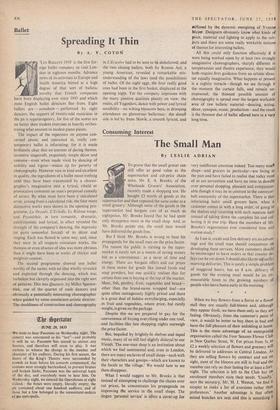Ballet
Spreading It Thin
By •A. V. COTON 'LES BALLETS 1958' is the first for- eign ballet company to visit Lon- don in eighteen months. Advance news of its activities in Europe and South America hinted at a high degree of that sort of .balletic novelty that French companies have been displaying ever since 1945 and which most English ballet directors flee from. Eight ballets are — somehow — performed by eight dancers; the support of twenty-odd musicians in the pit is supererogatory, for five of the scores are no better than student exercises in heavily orches- trating what amount to modest piano pieces.
The impact of the repertoire on anyone Con- cerned about, and interested in, really con- temporary ballet is infuriating; for it is made brilliantly clear that no amount of daring themes, inventive stagecraft, exquisitely simple decor and costume—even when made vivid by dancing of nobility and vigour—makes Up for poverty of choreography. However rare in kind and excellent in quality, the ingredients of a ballet mean nothing until they have been transmuted by a choreo- grapher's - imagination into a lyrical, ribald or provocative comment on man's perpetual comedy of errors. By what must have been a calculated error, arising from a calculated risk, the four more distinctive works were shown in the opening pro-' gramme. La Dryade, L'Echelle, Le Rideau rouge, and Promethee, in turn romantic, dramatic, exhibitionistic and lyrical, in effect revealed the strength of the company's dancing, the ingenuity (in parts somewhat forced) of its decor and staging. Each was flawed in some way, and, since they were in all respects miniature works, the thinness or even absence of idea was more obvious . than it might have been in works of thicker and weightier context.
• The second programme showed one ballet worthy of the name; with an idea wholly revealed and exploited through, the dancing, which was turbulent but cleverly organised into the right sort of patterns. This was Quatuor, by Milko Sparem- blek, one of the quartet of male dancers and obviously a potentially interesting choreographer when guided by some. omniscient artistic director. The shoddiness of construction and choreography in L'Ecuyere had to be seen to be disbelieved; and the two closing ballets, both by Ronnie Aul, a young American, revealed a remarkable mis- understanding of the laws (and the possibilities) of ballet. Of the eight eggs, the four really good ones had been in the first basket, displayed at the opening night. Yet the company impresses with the many positive qualities plainly on view; the males, all Yugoslays, dance with power and lyrical sensibility—no wilting blossoms here, in drooping attendance on glamotous 'ballerinas : the distaff side is led by Irene Skorik, a smooth lyricist, and stiffened by the dynamic energising of Yvonne Meyer. Designers obviously know what kinds of paint, material and lighting to apply to the sub- jects and there are some really workable notions of themes for interesting ballets.
All this could only function effectively if it were being worked upon by at least two strongly imaginative choreographers, sharply different in temperament and theatre experience; they would both require firm guidance from an artistic direc- tor equally imaginative. What happens at present is a nightly miracle—though we see through it the moment the curtain falls, and remain un- impressed; the thinnest possible amount of choreography is spread over the largest workable area of raw balletic material—dancing, acting. decor, synopsis, music, production—and the result is the thinnest diet of ballet offered here in a very long time.


































 Previous page
Previous page